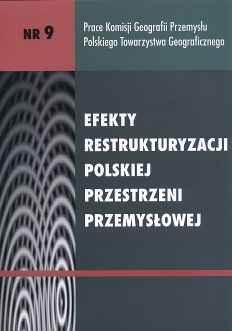A new model of the organisation and operation of old industrial enterprises
DOI:
https://doi.org/10.24917/20801653.9.8Keywords:
organizacja, przemysłAbstract
In the analysis of changes occurring in large Polish enterprises, special attention was paid to organisational changes as one of the chief aspects of their adaptation to the new economic conditions that also involves the formation of new spatial relations. The analysis makes use of the notional apparatus of the organisation and management science as a discipline concerned with changes in organisation and connected with the geography of enterprises.To give an empirical illustration of the changes, examples are provided of the restructuring of large enterprises like H. Cegielski Poznań S.A. and LECH Browary Wielkopolski S.A. (now Kompania Piwowarska S.A.). On the basis of the empirical research, several features were distinguished to characterise the organisational changes that had taken place in the chosen industrial plants. The organisational changes have mainly made the structures of those plants more flexible through giving autonomy to their internal organisational units, outsourcing and spin-offs. The result has been the appearance of a lot of new small and medium-sized businesses that have taken over the functions given up by the large enterprises. The spatial effect of those changes, in turn, has been the emergence of industrial agglomerations of a new type, with a large number of smaller firms connected through a cooperation network and chiefly performing orders of the large enterprises. Thus, what we observe here is a spatial concentration of collaborating firms and the appearance of agglomeration economies.There are also integration processes in which enterprises join the structures of international corporations, which makes them elements of the modern international industrial space and a part of the industrial networks set up by multinational firms.Downloads
Metrics
References
Ansoff H.I. 1985, Zarządzanie strategiczne, PWE, Warszawa
Domański B. 1992, Postfordowski elastyczny model produkcji a jej przestrzenna organizacja, Biuletyn KPZK PAN z. 159, Warszawa
Domański B. 1997, Geografia przedsiębiorstw – niedoceniany nurt badań w polskiej geografii ekonomicznej, [w:] Geografia, człowiek, gospodarka, red. B. Domański, A. Jackowski, Instytut Geografii UJ, Kraków
Koziński J. 1996, Struktury organizacyjne ugrupowań gospodarczych, [w:] Struktury organizacyjne przedsiębiorstw i ich ugrupowań, red. R. Krupski, M. Przybyła, Zakład Narodowy im. Ossolińskich, Wydawnictwo PAN, Wrocław–Warszawa–Kraków
Majchrzak J. 2001, Przekształcenia polskich przedsiębiorstw w świetle zmian organizacyjnych, Akademia Ekonomiczna w Poznaniu, Poznań
Nizard G. 1998, Metamorfozy przedsiębiorstwa. Zarządzanie w zmiennym otoczeniu organizacji, tł. Z. Podlasiak, PWN, Warszawa [oryg. 1991]
Przybyła M. 1996, Struktury organizacyjne przedsiębiorstw, [w:] Struktury organizacyjne przedsiębiorstw i ich ugrupowań, red. R. Krupski, M. Przybyła, Zakład Narodowy im. Ossolińskich, Wydawnictwo PAN, Wrocław–Warszawa–Kraków
Sapijaszka Z. 1996, Restrukturyzacja przedsiębiorstwa. Szanse i ograniczenia, Wydawnictwo Naukowe PWN, Warszawa
Stadtherr S. 1997, O niektórych finansowych uwarunkowaniach zmian strukturalnych w gospodarce,[w:] Struktury przemysłowe w gospodarce. Aspekty ekonomiczne, społeczno-kulturowe i polityczne, red. L. Olszewski, J. Morzymas, Wydawnictwo Uniwersytetu Wrocławskiego, Wrocław
Stryjakiewicz T. 1999, Adaptacja przestrzenna przemysłu w Polsce w warunkach transformacji, Wydawnictwo Naukowe UAM, Seria Geografia, 61, Poznań
Tobolska A. 2004, Zmiany własnościowe i organizacyjno-ekonomiczne w wybranych dużych przedsiębiorstwach przemysłowych Poznania w okresie transformacji, Bogucki Wydawnictwo Naukowe, Poznań
Downloads
Published
How to Cite
Issue
Section
License
Articles are published under the terms of the Creative Commons License (CC BY-ND 4.0; Attribution– NoDerivs).

